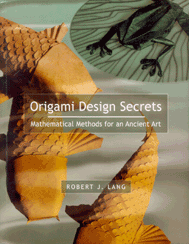
|
Origami Design Secrets: Mathematical Methods for an Ancient Art |
Buy it at:  
|
| Anne's Web Stuff > Anne's Personal Page > Origami > Origami Books > Book Details: Origami Design Secrets |
|
Book reviews generally spend quite a while waffling around, describing the book in question before summing up, but I'm going to get right to the point, here - if you're serious about origami, or think you want to become serious about origami, then buy this book.
For those of you who want more detail before you buy: Origami Design Secrets is an origami book unlike any other origami book to date (though we can always hope for more such wondrous content in future works by Robert Lang and other authors.) In addition to a fine selection of diagrams for twenty-two new models (details below) plus three designs for elephant heads used as a design example in chapter 3, it describes, in fascinating, engaging and well-written detail, the author's own design method, philosophy and, as the author puts it, his "bag of tricks" for origami design. The book is best read in sequence, as each chapter builds on the concepts and materials presented before; each chapter has a model or more illustrating the techniques described therein.
Origami Design Secrets is an astonishing 585 pages long, with the crease patterns, bases and drawing of the finished model for an extra 25 or so models in addition to the full instructions for the 25 new models. The text is interspersed with countless well-drawn diagrams illustrating techniques as they are described. The language and math levels throughout are geared towards an average origami practitioner with a high-school level mathematics background, making the book very approachable in spite of its technical content.
This book is surely destined to become one of those classics that later works reference - your origami bookshelf will be incomplete without a copy!
Note: all copyrighted text and photographic material from the book used in this review is so used by express permission of the author, and may not be redistributed. All errors and omissions are the responsibility of the author of this webpage.
Chapter 1: Introduction
From the Introduction:
"...I don't think of origami design as a cookbook process so much as a bag of tricks from which I select one or more in the design of a new model. Here is a base (a fundamental folding pattern) with six legs: I'll use it to make a beetle. Here is a technique for adding a pair of points to an existing base: I'll combine these to make wings. Some designers have deeper bags of tricks than others; some, like John Montroll, have a seemingly bottomless bag of tricks. I can't really teach the way to design origami, for there is no single way to design; but what I can and will try to do in this book, is to pass on some of the tricks from my bag. Origami design can indeed be pursued in a systematic fashion. There are now simple, codified mathematical and geometric techniques for developing a desired structure."
"This book is a collection of those techniques. It is not a step-by-step recipe book for design. Origami is, first and foremost, an art form, an expression of creativity, and it is the nature of creativity that it cannot be taught directly. However, it can be developed through example and practice. As in other art forms, you can learn techniques that serve as a springboard for creativity."
"The techniques of origami design that are described in this book are analogous to a rainbow of colors on an artist's palette. You don't need a broad spectrum, but while one can paint beautiful pictures using only black and white, the introduction of other colors immeasurably broadens the scope of what is possible... [H]aving a richer palette of techniques from which to choose can allow the origami artist to more fully express his or her artistic vision."
"As with any art, ability comes with practice, whether the art is origami folding or origami design. The budding origami designer develops his or her ability by designing and seeing the result... If you are a beginning designer, you should realize that no design is sacred. To learn to design, you must disregard reverence for another's model, and be willing to pull it apart, fold it differently, change it and see the effects of your changes..."
Chapter 2: The Building Blocks of Origami
"Chapter 2 introduces the fundamental building blocks of origami: the basic folds. If you have folded origami before, you may already be familiar with the symbols, terms and basic steps, but if not, it is essential that you read through this section. Chapter 2 also introduces a key concept: the relationship between the crease pattern and the folded form, a relationship that we will use and cultivate throughout the book."
Chapter 3: Elephant Design
"Chapter 3 initiates our foray into design by examining a few designs. The first stage of origami design is modification of an existing design; in this chapter, you will have an opportunity to explore this approach by devising simple modifications to a few figures."
The full folding sequences for three new elephant heads are included in the text of this chapter.
Chapter 4: Traditional Bases
"Chapter 4 introduces the concept of a base, a fundamental form from which many different designs may be folded. You will learn the traditional bases of origami, a number of variations on these bases, and several methods of modifying the traditional bases to alter their proportions."
 |
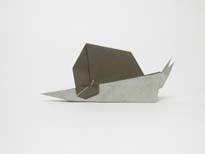 |
 |
| Model: Stealth Fighter (18 steps) |
Model: Snail (21 steps) |
Model: Valentine (45 steps) |
 |
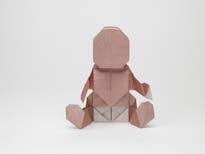 |
| Model: Ruby-Throated Hummingbird (41 steps) |
Model: Baby (49 steps) |
Chapter 5: Splitting Points
"Chapter 5 expands upon the idea of modifying a base by focusing upon modifications that turn a single point into two, three, or more simply by folding. This technique, called point-splitting, has obvious tactical value in designing, but it also serves as an introduction to the concept of modifying portions of a base while leaving others unchanged."
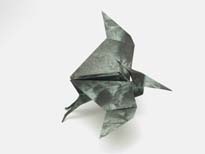 |
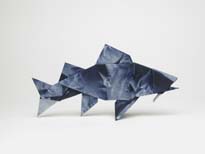 |
| Model: Pteranodon (47 steps) |
Model: Goatfish (69 steps) |
Chapter 6: Grafting
"Chapter 6 introduces the concept of grafting: modifying a crease pattern as if you had spliced into it additional paper for the purpose of adding structural elements to an existing form. Grafting is the simplest incarnation of a broader idea, that the crease patterns for origami bases are composed of separable parts."
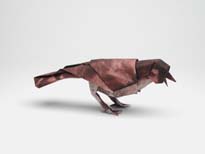 |
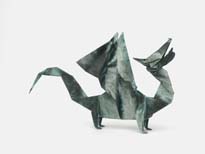 |
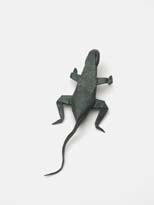 |
| Model: Songbird I (56 steps) |
Model: KNL Dragon (49 steps) |
Model: Lizard (45 steps) |
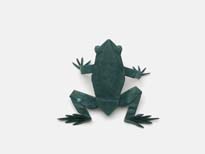 |
| Model: Tree Frog (101 steps) |
Chapter 7: Pattern Grafting
"Chapter 7 then expands up on the idea of grafting and shows how multiple intersecting grafts can be used to create patterns and textures within a figure - scales, plates, and other textures. This set of techniques stands somewhat independently, as almost any figure can be 'texturized.'"
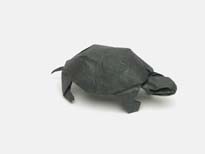 |
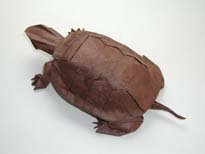 |
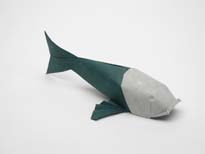 |
| Model: Turtle (27 steps) |
Model: Western Pond Turtle (76 steps) |
Model: Koi (36 steps) |
Chapter 8: Tiling
"Chapter 8 generalizes the concept of grafting to a set of techniques called tiling: cutting up and reassembling different pieces of crease patterns to make new bases. This chapter defines both tiles and matching rules that apply to the edges of tiles to insure that the assemblies of tiles can be folded into a flat shape. Chapter 8 also introduces the powerful concept of a uniaxial base - a family of structures that encompasses both the traditional origami bases and many of the most complex modern bases."
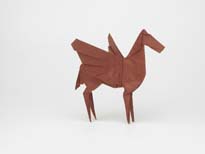 |
| Model: Pegasus (81 steps) |
Chapter 9: Circle Packing
"Chapter 9 shows how the tile decorations that enforce matching can be expanded into a design technique in their own right: the circle/river method, in which the solution of an origami base can be derived from packing circles into a square box. Circle/river packing is one of the most powerful design techniques around, capable of constructing figures with arbitrary configurations of flaps, and yet it can be employed using nothing more than a pencil and paper."
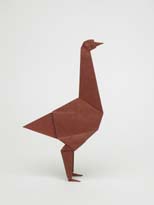 |
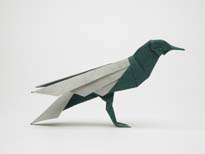 |
| Model: Emu (31 steps) |
Model: Songbird 2 (45 steps) |
Chapter 10: Molecules
"Chapter 10 explores more deeply the crease patterns within tiles; those that fit within circle/river designs are called molecules. The chapter presents the most common molecules, which are sufficient to construct full crease patterns for any uniaxial origami base."
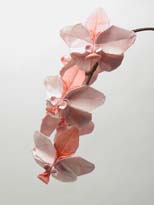 |
| Model: Orchid Blossom (39 steps) |
Chapter 11: Tree Theory
"Chapter 11 presents a different formulation of the circle/river packing solution for origami design, called tree theory, in which the design of the base is related to an underlying stick figure and the packing problem is related to a set of conditions applying to paths along the stick figure. Although equivalent to circle/river packing, the approach shown here is readily amenable to computer solution. It is the most mathematical chapter, but is in many ways the culmination of the ideas presented in the earlier chapters for designing uniaxial bases."
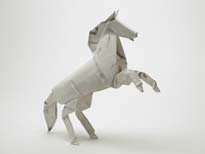 |
| Model: Alamo Stallion (75 steps) |
Chapter 12: Box Pleating
"Chapter 12 then introduces a particular style of origami called box pleating, which has been used for some of the most complex designs ever constructed. Box pleating in some ways goes beyond uniaxial bases; in particular, it can be used to construct fully three-dimensional figures. But it can also be implemented mathematically, and I will show how tree theory can be generalized to encompass box-pleated designs."
 |
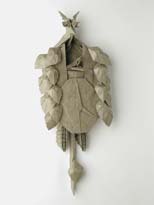 |
| Model: Bull Moose (80 steps) |
Model: Black Forest Cuckoo Clock (216 steps) |
Chapter 13: Hybrid Bases
"Chapter 13 continues to move beyond uniaxial bases, introducing the idea of hybrid bases, which combine elements from uniaxial bases with other non-uniaxial structures. The world of origami designs is enormously larger than the uniaxial bases that are the focus of this book, but as this chapter shows, elements from uniaxial bases can be combined with other structures, expanded, and extended, to yield ever-greater variety in origami figures."
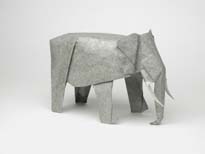 |
| Model: African Elephant (75 steps) |
Chapter 14: Algorithms
"...Chapter 14 presents a formal mathematical treatment of tree theory which will be best appreciate by those with a background in linear algebra and optimization theory."
References, Glossary of Terms, Index
The references section provides references and commentary, organized by chapter, with citations for material from both the mathematical and origami literature related to the concepts in each chapter.

Robert J. Lang has been an avid student of origami for over thirty years and is now recognized as one of the worldıs leading masters of the art, with over 400 designs cataloged and diagrammed. He is noted for designs of great detail and realism, and includes in his repertoire some of the most complex origami designs ever created. His work combines aspects of the Western school of mathematical origami design with the Eastern emphasis upon line and form to yield models that are at once distinctive, elegant, and challenging to fold. They have been shown in exhibitions in Paris (Carrousel du Louvre), New York, Boston, San Diego, and Tokyo, among others.
Dr. Lang was the first Westerner invited to address the Nippon (Japan) Origami Association's annual meeting (in 1992) and has been an invited guest at international origami conventions around the world. Dr. Lang is one of the pioneers of the cross-disciplinary marriage of origami with mathematics; he has been one of the few Western columnists for Origami Tanteidan Magazine, the journal of the Japan Origami Academic Society, and has presented several refereed technical papers on origami-math at mathematical and computer science professional meetings. He has consulted on applications of origami to engineering problems ranging from air-bag design to expandable space telescopes. He is the author or co-author of eight books and numerous articles on origami.
This page is: http://web.mit.edu/lavin/www/origami/books/details/1568811942/index.shtml
Last modified: Monday, 18-Oct-2004 22:27:58 EDT
All book data, images and content copyrighted by the book's author;
This web page copyright 2004 Anne R. LaVin
Please report any problems, errors or omissions here.